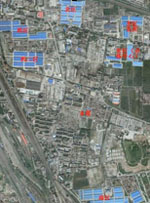Logistics technology flowers in China

China's thirst for knowledge about logistics and supply chain technology is evident from the growing number of trade shows showcasing the latest innovations. In 2009, logisticians in China could choose from nearly a dozen events where they could get "full firsthand experience in the charm of modern logistics," as one exhibition company phrased it.
According to TechnomicAsia, the Shanghai-based consulting unit of Tompkins Associates, adoption of logistics technology in that country is still in the "embryonic" stage, with only about 5 percent of warehouses reporting that they have sufficient IT systems. Some are taking matters into their own hands, reports Managing Director Steven Ganster in his blog on the company's Web site. "Many Chinese companies are writing their own WMS programs that are not built to international standards," he writes.
Still, proven logistics technologies are making inroads. A look at a directory of logistics and supply chain service offerings in China reveals such familiar names as RedPrairie, Descartes Systems, HighJump, IBM, Infor, JDA, Manhattan Associates, and SAP, to name just a few. Developers of other types of warehouse and DC solutions—bar-code readers, RFID systems, wireless communications, hand-held computers, and more—also are finding success in China.
Some of China's largest manufacturers and third-party logistics service providers (3PLs) have purchased logistics technology from U.S. and European vendors. Others have gained access to the technology they want through partnerships. For example, in 2007, China's largest logistics services company, Sinotrans, struck a deal with National Retail Systems, a U.S.-based logistics company with a strong technology focus, to form a joint venture called SinoNRS.
There are many more examples of logistics technology adoption in this rapidly growing market than we can include here. A brief look at just a few of them will provide an idea of the technical capabilities that are taking root and beginning to blossom in China.
WMS gain early acceptance
Warehouse management systems (WMS) attracted attention early on, in large part because China's
extraordinary export growth quickly overwhelmed manual warehouses and DCs. One of the earliest
WMS installations was by P.G. Logistics, one of China's first and largest 3PLs. In 2003, the 3PL
implemented a WMS from Infor in a distribution center it managed for Phillips Electronics. P.G.
Logistics has since extended the WMS to several other facilities to serve multinational customers
like Kraft Foods, Procter & Gamble, Samsung Electronics, and Unilever.
Other Chinese 3PLs quickly followed suit, incorporating warehousing software into their own operations. In 2006, for instance, Fanhang Logistics implemented RedPrairie's WMS solution. The following year, Hongxun Logistics selected HighJump Software's WMS. Tingtong Logistics is currently rolling out Manhattan Associates' ILS Integrated Logistics Solutions to 50 sites across China.
Earlier this year, Manhattan was named the top WMS provider in Asia by ARC Advisory Group in its Warehouse Management Systems Worldwide Outlook market analysis. But Western WMS suppliers should keep an eye out for potential domestic competition. In 2007, China's CDC Corp., a global software giant, strengthened its WMS offerings when it bought U.S.-based Catalyst International and folded it into its CDC Supply Chain division.
Follow that container!
Like logistics software, wireless technology and RFID are hot topics in China nowadays. China has
an active RFID association, and the technology is a frequent subject of conference sessions and
workshops. There is even a trade show devoted to radio-frequency identification: the China
International RFID Technologies and Applications Show in Logistics, Manufacturing, and
Anti-counterfeiting.
Given the vast distances between China's population centers and its fractured inland transportation system, it's no wonder RFID and other tracking and security technologies are generating interest. Savi Networks is just one of the developers that have jumped on this opportunity. In August, Savi announced that Shanghai-based Coscon Logistics would begin real-time, global positioning system (GPS) tracking of both domestic and international shipments using Savi's sensors.
Another player in container security in China is Powers International, which offers a satellite-based system. Late last year, Powers began collaborating with European Datacomm-Asia and Beijing-based Trade-Route to offer EDC-76, a "smart" container that provides origin-to-destination location and status information.
Wireless communication is showing up inside China's warehouses and DCs. Beijing-based 3PL Southwest Logistics has gone into wireless in a big way at its Southwest Logistics Center, a complex of eight warehouses plus offices and employee dormitories scattered throughout Beijing's Yushuzhuang district. The complex, which totals some 3 million square feet, provides receiving, storage, packaging, and domestic shipping and distribution services for more than 200 book publishers.
Southwest Logistics turned to wireless to solve two problems. First, some of the buildings are far apart geographically, and all of them are in a congested part of the city, which made it difficult to share information between the various locations. Second, the 3PL's rapid business growth had outstripped its manual warehouse operation's ability to keep up with demand. The company decided it needed a single, robust data network that could connect storehouses, offices, and residences. Also on its wish list: wireless access for hand-held terminals and security systems. Finally, it all had to be part of an integrated solution that could provide high-capacity bandwidth to ensure uninterrupted Internet access for transmission of voice, video, and data—not to mention extensive Wi-Fi coverage that could be easily expanded to accommodate the company's growth.

The Azalea wireless mesh network connects the Southwest Logistics Center buildings shown here in blue.
That was a lot to ask, but the supplier Southwest Logistics chose, Azalea Networks, had done it all before: Azalea was the principal provider of equipment for the "Wireless Beijing" project that established wireless broadband access across a 30-mile swath of the city during the 2008 Olympic Games.
The solution for the Southwest Logistics Center was "mesh" technology—a combination of outdoor and indoor wireless routers, with one or two routers per geographic zone to ensure coverage in all directions. Each router includes multiple radios, which allows different types of traffic to flow to and from the main network through the same router.
With the secure wireless network in place, Southwest Logistics' staff can access warehouse and logistics information via hand-held computers from any company location. They can also transmit data via their wireless terminals to the company's WMS. The wireless system additionally gave Southwest Logistics more flexibility when it came to locating video surveillance cameras, leading to better security at the warehouses. Furthermore, because voice and data communications travel over the same network, employees can make free voice calls anywhere within the company's network, which has significantly reduced communication costs.
Demand will grow
Some of the installations described here are as good as any you'll find elsewhere in the world. But
if you've done business in China, you know that those examples are not representative of the
average warehouse in that country.
It's likely, though, that software, RFID, wireless, and other logistics technologies will quickly gain currency in China. For one thing, the domestic third-party logistics industry will have to adopt the latest applications in order to compete with 3PLs that have brought their own systems with them from North America, Europe, and elsewhere in Asia. For another, foreign companies that do business in China expect to get the same kind of supply chain data there that they do in other markets.
The Chinese consumer will have as much to say about it as anyone. As the country's middle class grows and its standard of living rises, consumers will demand more consistent, reliable delivery of their orders—and they won't get it without modern logistics information systems.
Related Articles
Copyright ©2024. All Rights ReservedDesign, CMS, Hosting & Web Development :: ePublishing